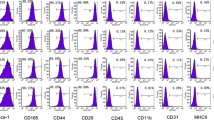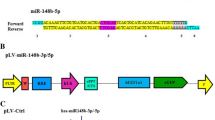Abstract
Noggin is a major extracellular antagonist to bone morphogenetic proteins (BMPs) which binds to BMPs and blocks binding of them to BMP-specific receptors and negatively regulates BMP-induced osteoblastic differentiation. In this study, we investigated the effect of noggin silencing by transfection of small interfering RNA (siRNA) on BMP-induced osteoblastic differentiation in vitro and ectopic bone formation in vivo induced by recombinant human BMP-2 (rhBMP-2). Noggin mRNA expression was up-regulated in response to rhBMP-2 in C2C12 cells, a myoblastic cell line, in dose- and time-dependent fashion as determined by real-time RT-PCR assay. Silencing of noggin expression by transfection of noggin siRNA suppressed BMP-stimulated noggin expression, resulting in acceleration of BMP-induced osteoblastic differentiation. For in vivo noggin silencing, siRNA was injected locally into back muscles and transfected into local cells by electroporation, where rhBMP-2-retaining (5 μg) collagen disks had been surgically placed. The implants were harvested at 2 weeks after surgery from experimental and control group mice and analyzed by radiological and histological methods. As a result, bone mineral content of ossicles ectopically induced by rhBMP-2 was significantly increased by silencing of noggin. Our findings suggest that silencing of noggin enhances the osteoblastic differentiation of BMP-responding cells in vitro and new bone formation induced by rhBMP-2 in vivo by eliminating negative regulation of the effects of BMP. RNA interference might be useful for intensifying the effects of BMP in promoting new bone (callus) formation in repair of damaged bone.





Similar content being viewed by others
References
Canalis E, Economides AN, Gazzerro E (2003) Bone morphogenetic proteins, their antagonists, and the skeleton. Endocr Rev 24:218–235
Gazzerro E, Canalis E (2006) Bone morphogenetic proteins and their antagonists. Rev Endocr Metab Disord 7:51–65
Boden SD, Kang J, Sandhu H, Heller JG (2002) Use of recombinant human bone morphogenetic protein-2 to achieve posterolateral lumbar spine fusion in humans: a prospective, randomized clinical pilot trial: 2002 Volvo award in clinical studies. Spine 27:2662–2673
Burkus JK, Gornet MF, Dickman CA, Zdeblick TA (2002) Anterior lumbar interbody fusion using rhBMP-2 with tapered interbody cages. J Spinal Disord Tech 15:337–349
Johnsson R, Stromqvist B, Aspenberg P (2002) Randomized radiostereometric study comparing osteogenic protein-1 (BMP-7) and autograft bone in human noninstrumented posterolateral lumbar fusion: 2002 Volvo award in clinical studies. Spine 27:2654–2661
Joseph V, Rampersaud YR (2007) Heterotopic bone formation with the use of rhBMP2 in posterior minimal access interbody fusion: a CT analysis. Spine 32:2885–2890
Valentin-Opran A, Wozney J, Csimma C, Lilly L, Riedel GE (2002) Clinical evaluation of recombinant human bone morphogenetic protein-2. Clin Orthop Relat Res 395:110–120
Kinoshita T, Kobayashi S, Ebara S, Yoshimura Y, Horiuchi H, Tsutsumimoto T, Wakabayashi S, Takaoka K (2000) Phosphodiesterase inhibitors, pentoxifylline and rolipram, increase bone mass mainly by promoting bone formation in normal mice. Bone 27:811–817
Horiuchi H, Saito N, Kinoshita T, Wakabayashi S, Tsutsumimoto T, Takaoka K (2001) Enhancement of bone morphogenetic protein-2-induced new bone formation in mice by the phosphodiesterase inhibitor pentoxifylline. Bone 28:290–294
Wakabayashi S, Tsutsumimoto T, Kawasaki S, Kinoshita T, Horiuchi H, Takaoka K (2002) Involvement of phosphodiesterase isozymes in osteoblastic differentiation. J Bone Miner Res 17:249–256
Horiuchi H, Saito N, Kinoshita T, Wakabayashi S, Yotsumoto N, Takaoka K (2002) Effect of phosphodiesterase inhibitor-4, rolipram, on new bone formations by recombinant human bone morphogenetic protein-2. Bone 30:589–593
Tsutsumimoto T, Wakabayashi S, Kinoshita T, Horiuchi H, Takaoka K (2002) A phosphodiesterase inhibitor, pentoxifylline, enhances the bone morphogenetic protein-4 (BMP-4)-dependent differentiation of osteoprogenitor cells. Bone 31:396–401
Horiuchi H, Saito N, Kinoshita T, Wakabayashi S, Tsutsumimoto T, Otsuru S, Takaoka K (2004) Enhancement of recombinant human bone morphogenetic protein-2 (rhBMP-2)-induced new bone formation by concurrent treatment with parathyroid hormone and a phosphodiesterase inhibitor, pentoxifylline. J Bone Miner Metab 22:329–334
Sasaoka R, Terai H, Toyoda H, Imai Y, Sugama R, Takaoka K (2004) A prostanoid receptor EP4 agonist enhances ectopic bone formation induced by recombinant human bone morphogenetic protein-2. Biochem Biophys Res Commun 318:704–709
Toyoda H, Terai H, Sasaoka R, Oda K, Takaoka K (2005) Augmentation of bone morphogenetic protein-induced bone mass by local delivery of a prostaglandin E EP4 receptor agonist. Bone 37:555–562
Imai Y, Terai H, Nomura-Furuwatari C, Mizuno S, Matsumoto K, Nakamura T, Takaoka K (2005) Hepatocyte growth factor contributes to fracture repair by upregulating the expression of BMP receptors. J Bone Miner Res 20:1723–1730
Sugama R, Koike T, Imai Y, Nomura-Furuwatari C, Takaoka K (2006) Bone morphogenetic protein activities are enhanced by 3’, 5’-cyclic adenosine monophosphate through suppression of Smad6 expression in osteoprogenitor cells. Bone 38:206–214
Zhao B, Katagiri T, Toyoda H, Takada T, Yanai T, Fukuda T, Chung UI, Koike T, Takaoka K, Kamijo R (2006) Heparin potentiates the in vivo ectopic bone formation induced by bone morphogenetic protein-2. J Biol Chem 281:23246–23253
Nakagawa K, Imai Y, Ohta Y, Takaoka K (2007) Prostaglandin E2 EP4 agonist (ONO-4819) accelerates BMP-induced osteoblastic differentiation. Bone 41:543–548
Namikawa T, Terai H, Hoshino M, Kato M, Toyoda H, Yano K, Nakamura H, Takaoka K (2007) Enhancing effects of a prostaglandin EP4 receptor agonist on recombinant human bone morphogenetic protein-2 mediated spine fusion in a rabbit model. Spine 32:2294–2299
Leboy PS (2006) Regulating bone growth and development with bone morphogenetic proteins. Ann N Y Acad Sci 1068:14–18
Groppe J, Greenwald J, Wiater E, Rodriguez-Leon J, Economides AN, Kwiatkowski W, Affolter M, Vale WW, Belmonte JC, Choe S (2002) Structural basis of BMP signalling inhibition by the cystine knot protein noggin. Nature 420:636–642
Abe E, Yamamoto M, Taguchi Y, Lecka-Czernik B, O’Brien CA, Economides AN, Stahl N, Jilka RL, Manolagas SC (2000) Essential requirement of BMPs-2/4 for both osteoblast and osteoclast formation in murine bone marrow cultures from adult mice: antagonism by noggin. J Bone Miner Res 15:663–673
Paine-Saunders S, Viviano BL, Economides AN, Saunders S (2002) Heparan sulfate proteoglycans retain noggin at the cell surface: a potential mechanism for shaping bone morphogenetic protein gradients. J Biol Chem 277:2089–2096
Zimmerman LB, De Jesus-Escobar JM, Harland RM (1996) The Spemann organizer signal noggin binds and inactivates bone morphogenetic protein 4. Cell 86:599–606
Devlin RD, Du Z, Pereira RC, Kimble RB, Economides AN, Jorgetti V, Canalis E (2003) Skeletal overexpression of noggin results in osteopenia and reduced bone formation. Endocrinology 144:1972–1978
Hannallah D, Peng H, Young B, Usas A, Gearhart B, Huard J (2004) Retroviral delivery of noggin inhibits the formation of heterotopic ossification induced by BMP-4, demineralized bone matrix, and trauma in an animal model. J Bone Joint Surg Am 86-A:80–91
Wan DC, Pomerantz JH, Brunet LJ, Kim JB, Chou YF, Wu BM, Harland R, Blau HM, Longaker MT (2007) Noggin suppression enhances in vitro osteogenesis and accelerates in vivo bone formation. J Biol Chem 282:26450–26459
Gazzerro E, Gangji V, Canalis E (1998) Bone morphogenetic proteins induce the expression of noggin, which limits their activity in cultured rat osteoblasts. J Clin Invest 102:2106–2114
Nakamura Y, Wakitani S, Nakayama J, Wakabayashi S, Horiuchi H, Takaoka K (2003) Temporal and spatial expression profiles of BMP receptors and noggin during BMP-2-induced ectopic bone formation. J Bone Miner Res 18:1854–1862
Nakamura Y, Wakitani S, Saito N, Takaoka K (2005) Expression profiles of BMP-related molecules induced by BMP-2 or -4 in muscle-derived primary culture cells. J Bone Miner Metab 23:426–434
Yoshimura Y, Nomura S, Kawasaki S, Tsutsumimoto T, Shimizu T, Takaoka K (2001) Colocalization of noggin and bone morphogenetic protein-4 during fracture healing. J Bone Miner Res 16:876–884
Nakamura T, Imai Y, Matsumoto T, Sato S, Takeuchi K, Igarashi K, Harada Y, Azuma Y, Krust A, Yamamoto Y, Nishina H, Takeda S, Takayanagi H, Metzger D, Kanno J, Takaoka K, Martin TJ, Chambon P, Kato S (2007) Estrogen prevents bone loss via estrogen receptor alpha and induction of fas ligand in osteoclasts. Cell 130:811–823
Wu L, Belasco JG (2008) Let me count the ways: mechanisms of gene regulation by miRNAs and siRNAs. Mol Cell 29:1–7
Acknowledgments
This work was supported in part by Grants-in-Aid from the Ministry of Education, Culture, Sports, Science, and Technology of Japan (Project Grants 16109009 and 1679085 to KT, and 19791018 to YI). Authors would like to thank Ms A. Inagaki, K. Hata, K. Kamei and Y. Hanamoto for their technical assistances.
Author information
Authors and Affiliations
Corresponding author
About this article
Cite this article
Takayama, K., Suzuki, A., Manaka, T. et al. RNA interference for noggin enhances the biological activity of bone morphogenetic proteins in vivo and in vitro. J Bone Miner Metab 27, 402–411 (2009). https://doi.org/10.1007/s00774-009-0054-x
Received:
Accepted:
Published:
Issue Date:
DOI: https://doi.org/10.1007/s00774-009-0054-x




